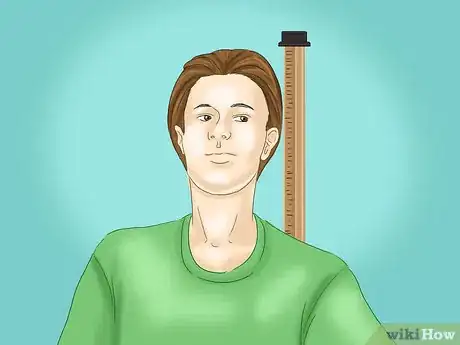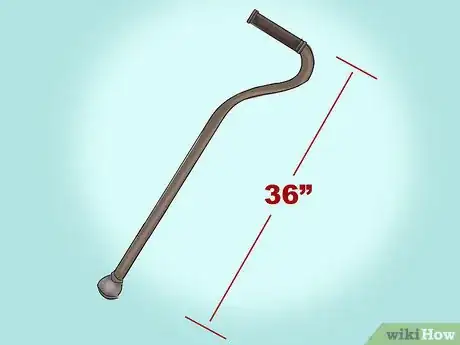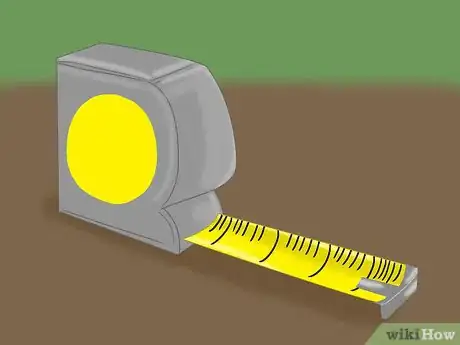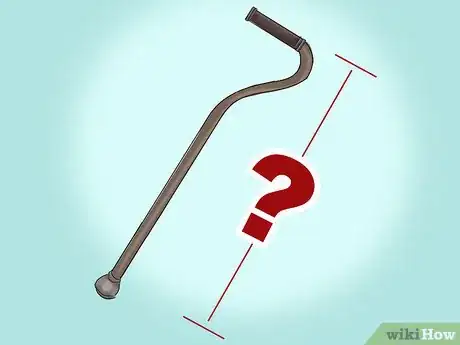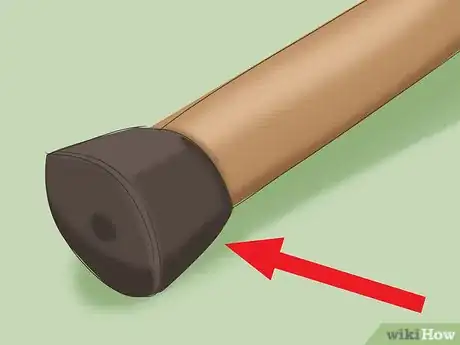This article was co-authored by Chris M. Matsko, MD. Dr. Chris M. Matsko is a retired physician based in Pittsburgh, Pennsylvania. With over 25 years of medical research experience, Dr. Matsko was awarded the Pittsburgh Cornell University Leadership Award for Excellence. He holds a BS in Nutritional Science from Cornell University and an MD from the Temple University School of Medicine in 2007. Dr. Matsko earned a Research Writing Certification from the American Medical Writers Association (AMWA) in 2016 and a Medical Writing & Editing Certification from the University of Chicago in 2017.
wikiHow marks an article as reader-approved once it receives enough positive feedback. This article received 12 testimonials and 90% of readers who voted found it helpful, earning it our reader-approved status.
This article has been viewed 349,115 times.
A walking cane can be either a temporary or permanent solution. You may need a cane for a short period of time following an injury or accident, or it may be your constant companion if you suffer from a chronic debilitating disease. Either way, determining the correct height of your walking cane is crucial because it leads to appropriate balance and stability, which allows you greater confidence (and safety) in your mobility and enhanced quality of life. However, determining the height is not always an exact science due to personal preferences, so use the following information as a guideline only.
Steps
Estimating Your Cane Length
-
1Estimate using your height. If you don't have a tape measure and you're ordering a cane online, you can estimate the size you might need by using your height as a general guide. A person between 76 and 79 inches tall should order a 38-inch cane, whereas those between 72 and 75 inches tall may find that a 37-inch cane suits them better.[1] The length of the cane you order should drop one inch for every three inches that you are under the suggested height ranges. For example, a person standing 64 to 67 inches tall should buy a 35-inch cane.
- Many canes are height adjustable, but some are not (particularly those carved from wood).
-
2Order a 36-inch cane if you're of average height. Because many people (particularly men) fall within the height range of 68–71 inches (170–180 cm), most canes are manufactured or adjusted to 36 inches (91.4 cm) in length.[2] As a default, some cane manufacturers send 36-inch canes to online customers automatically unless they specify a different length.
- Walking with a cane that's either too long or short can lead to more aches and pains, especially in your elbow, shoulder and neck.
Advertisement -
3Borrow a cane from someone of similar size. If a friend or family member temporarily needed a cane to help recover from an accident or injury, and if they are the same height as you, then ask them if you can borrow or buy it. If they were properly measured for the cane and tend to wear similar shoes to you, then their cane may be a great fit for you.
- When trying to correlate your height to the length of a cane, remember to factor in the height of your shoes because you likely won't be using the cane without them.[3]
Being More Precise
-
1Use a measuring tape. The most precise way to determine the correct cane length for you is by measuring the distance between your hand and the ground while you wear shoes. With your arm hanging straight down at your side, the top of your cane should line up with the crease in your wrist.[4] In other words, the number of inches between your wrist and the floor is the length that your cane should be.
- With the cane in hand, your elbow should bend at a comfortable angle — about 15 degrees or so.[5] Bending your elbow a little more is okay if you're primarily using the cane for balance instead of weight support.
-
2Measure differently if you're hunched over. You should consider measuring yourself differently if you have a condition that does not allow you to stand up straight. In this case, you'll likely need a shorter cane than that normally dictated by your height. Thus, measure the distance between the floor and wherever your wrist is as you walk with shoes on. Get a friend to help if need be.
- If your cane is too short, you might lean to one side — which can throw you off balance.
-
3Get professional assistance. If you find it too difficult to make the appropriate measurements for your walking cane, then your best bet is to have your physician or physical therapist help you with it. Try asking your doctor to write you a prescription for a cane. You may also want go to a medical supply store and ask a sales associate to help you out with finding the right cane for you. Your doctor or a sales associate can also recommend the most appropriate material for your cane, as well as the handle shape and type of grip.
- Normally the hand you hold the cane with is on the opposite side of the injury, but sometimes it's the same side — your doctor or physiotherapist can determine the correct side for your situation.[6]
Considering Your Options
-
1Try different cane lengths. Although measuring the distance from your wrist to the floor is the "gold standard" of determining cane length, you may prefer a slightly different height based on many physiological factors, such as the flexibility or strength in your hands, wrists, elbows or shoulders. For example, if you can't bend your elbow very much, you might need a cane that's a little shorter.
- Try a few different lengths of canes while at the medical supply store or your physician's or physiotherapist's office before determining the perfect size for your particular condition.
- Choose a walking cane based on function as well as personal preference.
-
2Consider what your cane is for. Many people who carry a walking cane use it primarily for balance (especially when walking on unbalanced or slippery surfaces), as opposed to needing it to support the majority of their body weight. The length of your cane doesn't need to be as precise if you're using it mainly for balance instead of weight bearing / support.[7]
- There are different kinds of canes. Some have one tip while other have four tips. The ones with four tips provide more stability but these canes are harder to use. [8]
- Not all walking canes are designed to support all of your body weight, especially if you're obese.[9] As such, perhaps you should consider crutches or a wheelchair if you need more support.
-
3Choose a grip that works for you. Canes also have different types of grips. For example, you can get a cane with a foam handle grip with or without a cuff that fits around your arm. You can also get a cane that has a large handle to make it easier for you to hold onto.[10]
- Try gripping different types of cane handles to see what feels the most comfortable for you.
-
4Don't forget about the tip. Walking canes typically come with rubber or plastic tips on the end, which provide grip but they also affect the height of the cane.[11] So when measuring the cane, always take into consideration the size of the tip. Furthermore, when the tips wear down with use, the cane's height will reduce somewhat, so remember to replace worn out tips.
- The pliable rubber tips on the ends of canes grip the floor much like the tread on tires grip the road. Make sure your cane has a tip that is in good shape. If you need to replace the tip, then go to a medical supply store and buy a new one.
- When buying a cane, make sure the rubber tip is supple and the tread is in good shape.
Expert Q&A
Did you know you can get expert answers for this article?
Unlock expert answers by supporting wikiHow
-
QuestionHow do I make sure I have the right height walking stick?
 Chris M. Matsko, MDDr. Chris M. Matsko is a retired physician based in Pittsburgh, Pennsylvania. With over 25 years of medical research experience, Dr. Matsko was awarded the Pittsburgh Cornell University Leadership Award for Excellence. He holds a BS in Nutritional Science from Cornell University and an MD from the Temple University School of Medicine in 2007. Dr. Matsko earned a Research Writing Certification from the American Medical Writers Association (AMWA) in 2016 and a Medical Writing & Editing Certification from the University of Chicago in 2017.
Chris M. Matsko, MDDr. Chris M. Matsko is a retired physician based in Pittsburgh, Pennsylvania. With over 25 years of medical research experience, Dr. Matsko was awarded the Pittsburgh Cornell University Leadership Award for Excellence. He holds a BS in Nutritional Science from Cornell University and an MD from the Temple University School of Medicine in 2007. Dr. Matsko earned a Research Writing Certification from the American Medical Writers Association (AMWA) in 2016 and a Medical Writing & Editing Certification from the University of Chicago in 2017.
Family Medicine Physician
References
- ↑ http://traveltips.usatoday.com/proper-height-walking-cane-63172.html
- ↑ http://traveltips.usatoday.com/proper-height-walking-cane-63172.html
- ↑ https://www.ncbi.nlm.nih.gov/pmc/articles/PMC2231545/
- ↑ http://www.mayoclinic.org/healthy-lifestyle/healthy-aging/multimedia/canes/sls-20077060?s=3
- ↑ http://www.mayoclinic.org/healthy-lifestyle/healthy-aging/multimedia/canes/sls-20077060?s=3
- ↑ https://www.merckmanuals.com/professional/geriatrics/gait-disorders-in-older-adults/gait-disorders-in-older-adults
- ↑ https://www.merckmanuals.com/professional/geriatrics/gait-disorders-in-older-adults/gait-disorders-in-older-adults
- ↑ https://www.ncbi.nlm.nih.gov/pmc/articles/PMC2231545/
- ↑ http://traveltips.usatoday.com/proper-height-walking-cane-63172.html
About This Article
To determine the correct height for a walking cane, buy a 36 inch cane if you're of average height, which is between 68 and 71 inches. If you're between 64 and 67 inches tall, purchase a 35 inch cane. Alternatively, opt for a 37 inch cane if you’re between 72 and 75 inches tall. If you want to be more precise, put on a pair of shoes and hold your arms by your sides. Then, use a measuring tape to measure the distance from the crease in your wrist to the ground. For tips on how to choose the right cane grip, read on!
